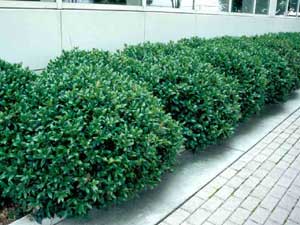Landscape Shrubs
Carissa Chinese Holly
(Ilex cornuta 'Carissa')
The Chinese holly (Ilex cornuta) is like the native Yaupon holly (I. vomitoria) in some respects, in that it offers many options when landscaping. Chinese holly cultivars range from large screen plants like ‘Burfordii’ to the well-behaved and smaller ‘Carissa.’
One trademark of most Chinese hollies is the distinctive, glossy dark green leaves with five to nine prominent spines on the margin. These are not minor serrations, but more like sharks’ teeth. Cultivars such as ‘Rotunda’ would make an excellent substitute for barbed wire.
While the leaves on many cultivars of Chinese holly may be hazardous, they are still very attractive. The very dark leaves have a distinctive luster. In contrast to the small leaves on Yaupon holly (I. vomitoria) or Japanese holly (I. crenata), Chinese holly leaves are larger and therefore provide a coarser texture to the landscape. Like most other hollies, it is a broadleaf evergreen, so there is no fall color.
Similar to most hollies, the flowers are not worth talking about. The small greenish white flowers appear in late March or early April. Like other hollies, Chinese holly plants are either male or female (referred to as dioecious). Most people want the 1/3” red fruits, so we select female cultivars. No need to bother about purchasing a male pollinator, as there is more than enough pollen floating in the air to get the job done.
The Burford (‘Burfordii’) holly is kind of an exception. Burford holly has a heavy fruit set without pollination (referred to as parthenocarpy). Many gardeners use red-fruited branches during the winter holidays for all kinds of decorating, so Chinese holly serves another purpose at that time of year.
A brief summary of some of the most common cultivars:
- ‘Burfordii’ is a common hedge plant, 18’ tall x 15’; its leaves typically have only one terminal spine.
- ‘Carissa’ is a favorite foundation plant of mine: 4’ tall x 5’ wide, a tight globe without pruning, the leaves again with only one terminal spine (so less hazardous), and no fruit.
- ‘Dwarf Burfordii’ is a slightly smaller form of ‘Burfordii’ and the leaves are more puckered.
- ‘Needlepoint’ is an excellent form for screening (15’ tall x 10’ wide); it has more delicate leaves than Burford and has good fruit set.
- ‘O. Spring’ is an upright form (15’ tall x 18’ wide) with yellow-green, distinctively variegated leaves; it was named after an Oklahoma nurseryman, Otto Spring.
- ‘Rotunda,’ is a dense, rounded plant like ‘Carissa,’ but with pronounced marginal teeth; it is also rarely seen with fruit.
‘Rotunda’ and ‘Carissa’ are excellent options as foundation plants; ‘O. Spring’ is a good specimen, and ‘Burfordii’ and ‘Needlepoint’ make good hedge or screen plants.
Culture on Chinese holly is similar to other broadleaf evergreens. In general these plants do not tolerate heavy, wet soils often found in new construction sites. The first sign of trouble is a general yellowing of leaves. Leaf density will decrease in dense shade, so plants should be placed in partial to full sun. While cold hardiness is listed as Zones 7 (Little Rock) and 8 (Hope), some cultivars may have shoot dieback in Zone 6 (Fayetteville) in severely cold winters.
The most consistent problem on Chinese holly is scale-type insects. One other oddity is worth mentioning. In late winter it is not unusual to see significant leaf yellowing on Chinese holly cultivars with heavy fruit production. A plausible explanation is that fruit set is so heavy it pulls substantial nutrients from the leaves on the same branch. Point: don’t worry, it is not a disease.
- Common Name: Chinese holly
- Varieties to look for: ‘Burfordii,’ ‘Carissa,’ ‘Rotunda’
- Flower Color: greenish-white, but not showy
- Blooming period: mid-spring
- Perennial or annual: broadleaf evergreen shrub
- Size: variable
- Exposure: partial sun to sun
- Soil: demand good drainage
- Watering: moist best
- When to prune: anytime
- When to fertilize: spring or fall
- Suggested use: foundation, screen, hedge
Form
